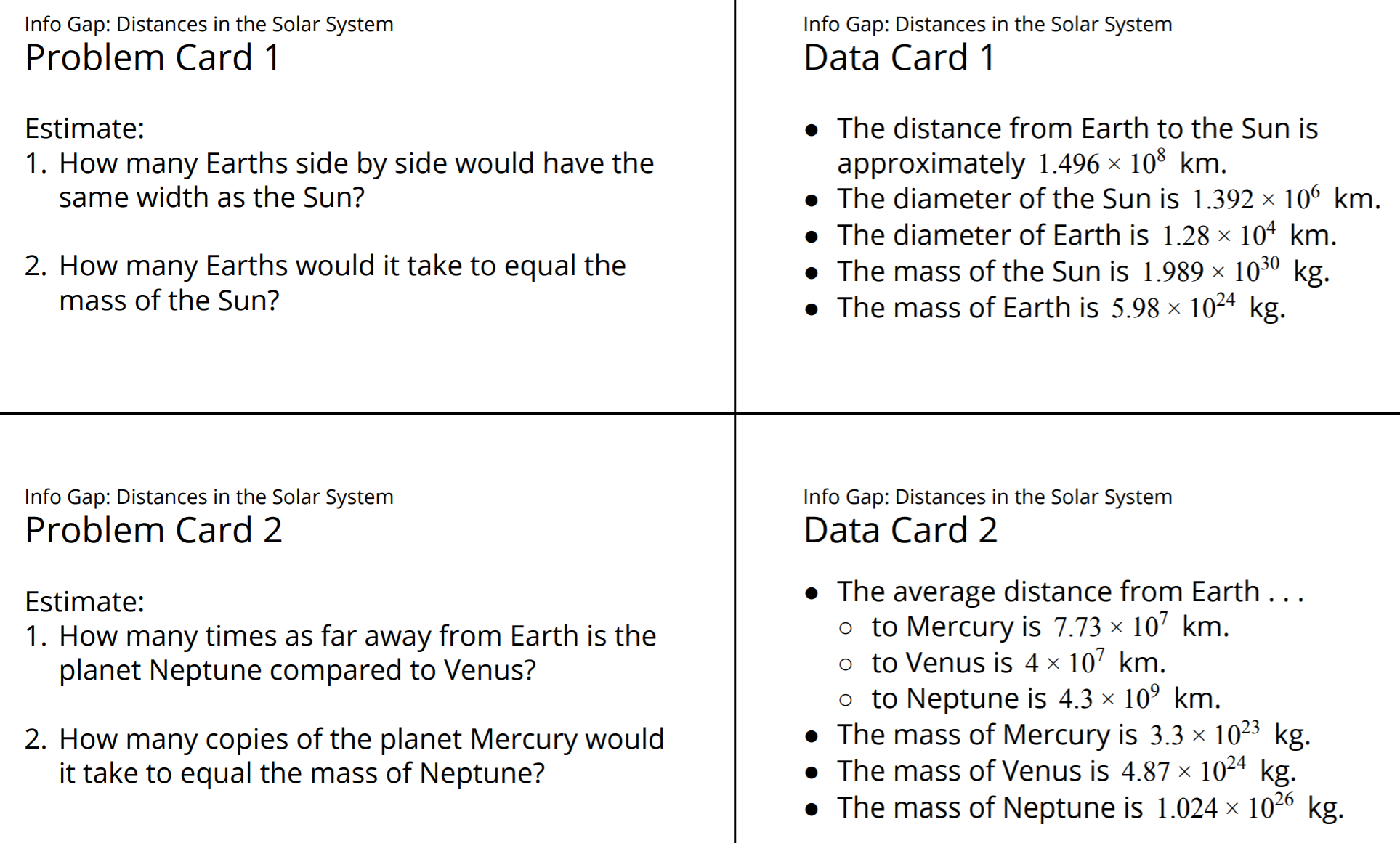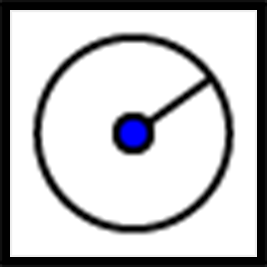Lesson 13
Multiplying, Dividing, and Estimating with Scientific Notation
13.1: True or False: Equations (5 minutes)
Warm-up
The purpose of this warm-up is to encourage students to apply the properties of integer exponents to reason about equivalent expressions. While students may evaluate each side of the equation to determine if it is true or false, encourage students to reason about the properties of exponents and operations in their solution.
Launch
Display one problem at a time. Tell students to give a signal when they have decided if the equation is true or false. Give students 2 minutes of quiet think time followed by a whole-class discussion.
Student Facing
Is each equation true or false? Explain your reasoning.
- \(4\times 10^5 \times 4 \times 10^4= 4\times 10^{20}\)
- \(\dfrac{7 \times 10^6}{2 \times 10^4} = (7\div2) \times 10^{(6-4)}\)
- \(8.4 \times 10^3 \times 2 = (8.4 \times 2) \times 10^{(3 \times 2)}\)
Student Response
For access, consult one of our IM Certified Partners.
Activity Synthesis
Ask students to share their strategies for each problem. Record and display their responses for all to see. To involve more students in the conversation, consider asking:
- “Do you agree or disagree? Why?”
- “Who can restate ___’s reasoning in a different way?”
- “Does anyone want to add on to _____’s reasoning?”
After each false equation, ask students how the problem could be changed to make the equation true.
13.2: Biomass (15 minutes)
Activity
In this activity, students answer questions about quantities in context. They use scientific notation as a tool for working with small and large numbers—to describe quantities, make estimates, and make comparisons (e.g., to express how many times as much one is as the other).
Launch
If possible, display an attention-grabbing image of cats and people for all to see. Ask students, “How many humans do you think there are for each cat in the world?” Ask for estimates that are too high, too low, and as reasonable as possible.
Explain that large numbers like populations are often estimated using scientific notation. There are an estimated \(7.5 \times 10^9\) humans and \(6 \times 10^8\) cats in the world. Guide students through the example \(\frac{7.5 \times 10^9}{6 \times 10^8} = \frac{7.5}{6} \times 10^{9-8} = 1.25 \times 10^1 = 12.5\). So there are roughly 12.5 humans for each cat.
Arrange students in groups of 2 to allow partner discussions as they work. Select a student to read the first paragraph before telling students to answer the questions. Tell students that estimation will help answer these questions much more easily, so if they get stuck computing, they should try to make reasonable estimates. For example, estimating the number of humans for each cat could have looked like \(\frac{7.5 \times 10^9}{6 \times 10^8} \approx \frac{6 \times 10^9}{6 \times 10^8} = 1 \times 10^1 = 10\). In this case, the final estimate is within 20% of the original calculation (not very accurate, but within a power of 10).
Give groups 10–12 minutes to work, followed by a brief whole-class discussion.
Supports accessibility for: Memory; Conceptual processing
Design Principle(s): Maximize meta-awareness; Support sense-making
Student Facing
Use the table to answer questions about different creatures on the planet. Be prepared to explain your reasoning.
| creature | number | mass of one individual (kg) |
|---|---|---|
| humans | \(7.5 \times 10^9\) | \(6.2 \times 10^1\) |
| cows | \(1.3 \times 10^9\) | \(4 \times 10^2\) |
| sheep | \(1.75 \times 10^9\) | \(6 \times 10^1\) |
| chickens | \(2.4 \times 10^{10}\) | \(2 \times 10^0\) |
| ants | \(5 \times 10^{16}\) | \(3 \times 10^{\text -6}\) |
| blue whales | \(4.7 \times 10^3\) | \(1.9 \times 10^5\) |
| Antarctic krill | \(7.8 \times 10^{14}\) | \(4.86 \times 10^{\text -4}\) |
| zooplankton | \(1 \times 10^{20}\) | \(5 \times 10^{\text -8}\) |
| bacteria | \(5 \times 10^{30}\) | \(1 \times 10^{\text -12}\) |
- Which creature is least numerous? Estimate how many times more ants there are.
- Which creature is the least massive? Estimate how many times more massive a human is.
- Which is more massive, the total mass of all the humans or the total mass of all the ants? About how many times more massive is it?
- Which is more massive, the total mass of all the krill or the total mass of all the blue whales? About how many times more massive is it?
Student Response
For access, consult one of our IM Certified Partners.
Anticipated Misconceptions
Students may need help remembering how to estimate using a single digit times a power of 10. Remind these students that \(1.9 \times10^5\), for example, could be estimated as \(2 \times 10^5\) to make calculation easier.
Activity Synthesis
Select students to explain how they used scientific notation and estimation to compare quantities. Record and display their reasoning for all to see. After each student presents, ask others if they reasoned the same way and if there are other approaches.
Students should see that being able to multiply and divide quantities in scientific notation is particularly helpful for reasoning and estimating about very large or very small quantities, which would be challenging to work with in their decimal representations.
13.3: Info Gap: Distances in the Solar System (15 minutes)
Activity
In this info gap activity, students continue to use scientific notation as a tool for working with small and large numbers—to describe quantities, make estimates, and make comparisons (e.g., to express how many times as much one is as the other).
The info gap structure requires students to make sense of problems by determining what information is necessary, and then to ask for information they need to solve it. This may take several rounds of discussion if their first requests do not yield the information they need (MP1). It also allows them to refine the language they use and ask increasingly more precise questions until they get the information they need (MP6).
As students work, identify those who use slightly different estimations to compare during whole-class discussion. While students may have slightly different results based on their estimations, the results should be relatively close in value compared to the power of 10.
Here is the text of the cards for reference and planning:

Launch
Arrange students in groups of 2. In each group, distribute a problem card to one student and a data card to the other student.
The digital version of this activity includes an extension that challenges students to create their own scale drawing of the planets. They need to calculate values for the radii and follow the simple steps in the activity.
Supports accessibility for: Memory; Organization
Design Principle(s): Cultivate Conversation
Student Facing
Your teacher will give you either a problem card or a data card. Do not show or read your card to your partner.
If your teacher gives you the problem card:
- Silently read your card and think about what information you need to answer the question.
- Ask your partner for the specific information that you need.
- Explain to your partner how you are using the information to solve the problem.
- Solve the problem and explain your reasoning to your partner.
If your teacher gives you the data card:
- Silently read the information on your card.
- Ask your partner “What specific information do you need?” and wait for your partner to ask for information. Only give information that is on your card. (Do not figure out anything for your partner!)
- Before telling your partner the information, ask “Why do you need that information?”
- After your partner solves the problem, ask them to explain their reasoning and listen to their explanation.
Pause here so your teacher can review your work. Ask your teacher for a new set of cards and repeat the activity, trading roles with your partner.
Student Response
For access, consult one of our IM Certified Partners.
Student Facing
Are you ready for more?
Choose two celestial objects and create a scale drawing of them in the applet below.
| object | distance to Earth (km) | diameter (km) | mass (kg) |
|---|---|---|---|
| Sun | \(1.496 \times 10^8\) | \(1.392 \times 10^6\) | \(1.989 \times 10^{30}\) |
| Mercury | \(7.73 \times 10^7\) | \(4.878 \times 10^3\) | \(3.3 \times 10^{23}\) |
| Venus | \(4 \times 10^7\) | \(1.21 \times 10^4\) | \(4.87 \times 10^{24}\) |
| Earth | N/A | \(1.28 \times 10^4\) | \(5.98 \times 10^{24}\) |
| Mars | \(5.46 \times 10^7\) | \(6.785 \times 10^3\) | \(6.4 \times 10^{23}\) |
| Jupiter | \(5.88 \times 10^8\) | \(1.428 \times 10^5\) | \(1.898 \times 10^{27}\) |
| Saturn | \(1.2 \times 10^9\) | \(1.199 \times 10^5\) | \(5.685 \times 10^{26}\) |
| Uranus | \(2.57 \times 10^9\) | \(5.149 \times 10^4\) | \(8.68 \times 10^{25}\) |
| Neptune | \(4.3 \times 10^9\) | \(4.949 \times 10^4\) | \(1.024 \times 10^{26}\) |


Student Response
For access, consult one of our IM Certified Partners.
Launch
Arrange students in groups of 2. In each group, distribute a problem card to one student and a data card to the other student.
The digital version of this activity includes an extension that challenges students to create their own scale drawing of the planets. They need to calculate values for the radii and follow the simple steps in the activity.
Supports accessibility for: Memory; Organization
Design Principle(s): Cultivate Conversation
Student Facing
Your teacher will give you either a problem card or a data card. Do not show or read your card to your partner.
If your teacher gives you the problem card:
- Silently read your card and think about what information you need to answer the question.
- Ask your partner for the specific information that you need.
- Explain to your partner how you are using the information to solve the problem.
- Solve the problem and explain your reasoning to your partner.
If your teacher gives you the data card:
- Silently read the information on your card.
- Ask your partner “What specific information do you need?” and wait for your partner to ask for information. Only give information that is on your card. (Do not figure out anything for your partner!)
- Before telling your partner the information, ask “Why do you need that information?”
- After your partner solves the problem, ask them to explain their reasoning and listen to their explanation.
Pause here so your teacher can review your work. Ask your teacher for a new set of cards and repeat the activity, trading roles with your partner.
Student Response
For access, consult one of our IM Certified Partners.
Anticipated Misconceptions
Some students may not recognize that “width” and “diameter” refer to the same measurement in this context. If needed, prompt students with Data Card 1 to give the information about the diameter when their partner asks for the width.
Activity Synthesis
Select students to explain how they used scientific notation and estimation to compare the sizes of objects in the solar system. Poll the class on whether they estimated the same way. Ask previously identified students (who had slightly different ways of estimating) to compare their estimates and to show that any reasonable estimate will differ by an amount that is much smaller than the given quantities.
If time allows, discuss how scientific notation was useful in answering these questions.
13.4: Professions in the United States (15 minutes)
Optional activity
This activity gives students additional practice using scientific notation to work with small and large numbers and answering questions about quantities in context. Students express numbers in the form of a single digit times an integer power of 10 to estimate very large or very small quantities, as well as to determine how many times as much one is than the other.
Launch
Give students a minute of quiet time to observe the values in the table. Ask them to be prepared to share at least one thing they notice and one thing they wonder. Then, invite students to share their observations and questions. Consider recording their responses for all to see and using students' observations or questions about scientific notation, order of magnitude, and place values to orient students to the work in the activity.
Tell students that estimation will make it much easier to answer these questions. Give students 10–12 minutes to work, followed by a brief whole-class discussion.
Supports accessibility for: Memory; Conceptual processing
Design Principle(s): Optimize output (for explanation)
Student Facing
Use the table to answer questions about professions in the United States as of 2012.
| profession | number | typical annual salary (U.S. dollars) |
|---|---|---|
| architect | \(1.074 \times 10^5\) | \(7.3 \times 10^4\) |
| artist | \(5.14 \times 10^4\) | \(4.4 \times 10^4\) |
| programmer | \(1.36 \times 10^6\) | \(8.85 \times 10^4\) |
| doctor | \(6.9 \times 10^5\) | \(1.87 \times 10^5\) |
| engineer | \(6.17 \times 10^5\) | \(8.6 \times 10^4\) |
| firefighter | \(3.07 \times 10^5\) | \(4.5 \times 10^4\) |
| military—enlisted | \(1.16 \times 10^6\) | \(4.38 \times 10^4\) |
| military—officer | \(2.5 \times 10^5\) | \(1 \times 10^5\) |
| nurse | \(3.45 \times 10^6\) | \(6.03 \times 10^4\) |
| police officer | \(7.8 \times 10^5\) | \(5.7 \times 10^4\) |
| college professor | \(1.27 \times 10^6\) | \(6.9 \times 10^4\) |
| retail sales | \(4.67 \times 10^6\) | \(2.14 \times 10^4\) |
| truck driver | \(1.7 \times 10^6\) | \(3.82\times 10^4\) |
Answer the following questions about professions in the United States. Express each answer in scientific notation.
- Estimate how many times more nurses there are than doctors.
- Estimate how much money all doctors make put together.
- Estimate how much money all police officers make put together.
- Who makes more money, all enlisted military put together or all military officers put together? Estimate how many times more.
Student Response
For access, consult one of our IM Certified Partners.
Activity Synthesis
Select students who use slightly different estimations and discuss how their answers are different, but very close compared to the size of the numbers they are working with. The main idea is that students can use a single digit times a power of 10 to estimate numbers and use what they know about exponent arithmetic to compare how many times larger one value is than another.
Lesson Synthesis
Lesson Synthesis
The discussion should focus on why scientific notation is helpful in making multiplicative comparisons of numbers.
- “What did you notice about the numbers in the tables you saw today?” (They were all written in scientific notation.)
- “A number is expressed in scientific notation if it is the product of an integer power of 10 and a number greater than or equal to 1 but less than 10. How does the convention about the numeric factor help us quickly get an idea about the size of a number? How does it help us compare numbers?” (Since the factor is always less than 10, the exponent gives most of the information about size of the number. Numbers can be compared by quickly examining the exponents and rounding the numerical factor.)
- “Suppose we had a table where the numbers were not in scientific notation. Would you be able to take a quick look at the table and have a feel for the relative sizes of the numbers? Describe how the process of answering 'how many times as great' questions would be different for such a table than the work you did with today’s problems.” (If the numbers were written using different powers of 10, we would need to look at both the first factor and the power of 10 to gauge the size of each number. If the numbers were written as decimals, it would be even more challenging, as it would require counting zeros or decimal places. Multiplying and dividing these numbers—to answer ‘how many times as great’ questions—would also be much more cumbersome and prone to error.)
13.5: Cool-down - Estimating with Scientific Notation (5 minutes)
Cool-Down
For access, consult one of our IM Certified Partners.
Student Lesson Summary
Student Facing
Multiplying numbers in scientific notation extends what we do when we multiply regular decimal numbers. For example, one way to find \((80)(60)\) is to view 80 as 8 tens and to view 60 as 6 tens. The product \((80)(60)\) is 48 hundreds or 4,800. Using scientific notation, we can write this calculation as \(\displaystyle (8 \times 10^1) (6 \times 10^1) = 48 \times 10^2.\) To express the product in scientific notation, we would rewrite it as \(4.8 \times 10^3\).
Calculating using scientific notation is especially useful when dealing with very large or very small numbers. For example, there are about 39 million or \(3.9 \times 10^7\) residents in California. Each Californian uses about 180 gallons of water a day. To find how many gallons of water Californians use in a day, we can find the product \((180) (3.9 \times 10^7) = 702 \times 10^7\), which is equal to \(7.02 \times 10^9\). That’s about 7 billion gallons of water each day!
Comparing very large or very small numbers by estimation also becomes easier with scientific notation. For example, how many ants are there for every human? There are \(5 \times 10^{16}\) ants and \(7 \times 10^9\) humans. To find the number of ants per human, look at \(\frac{5 \times 10^{16}}{7 \times 10^9}\). Rewriting the numerator to have the number 50 instead of 5, we get \(\frac{50 \times 10^{15}}{7 \times 10^9}\). This gives us \(\frac{50}{7} \times 10^6\). Since \(\frac{50}{7}\) is roughly equal to 7, there are about \( 7 \times 10^6\) or 7 million ants per person!